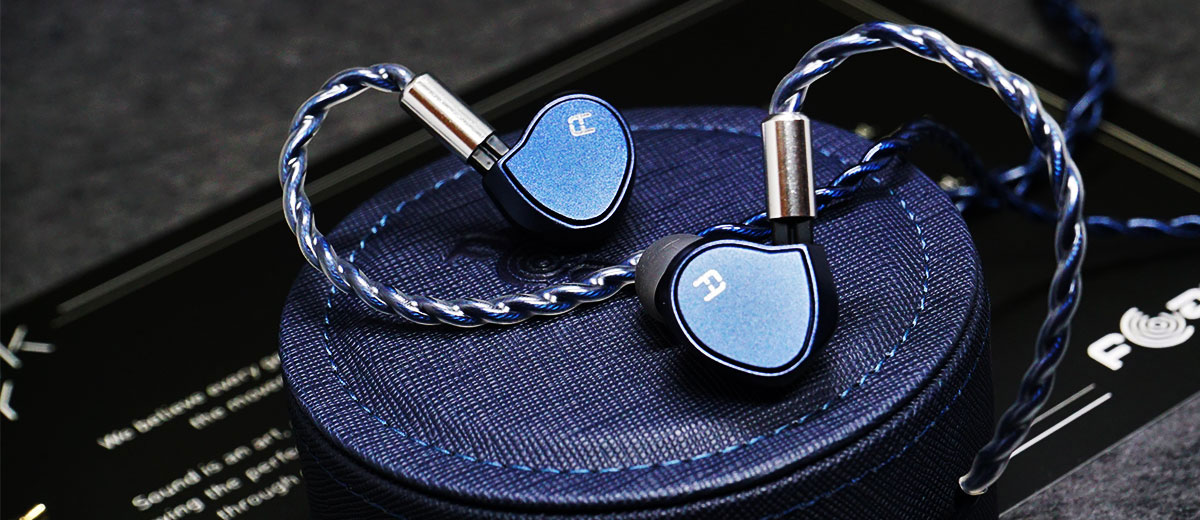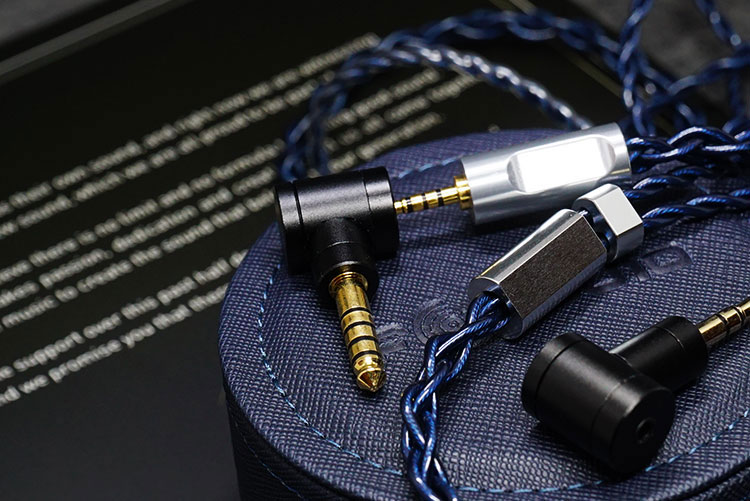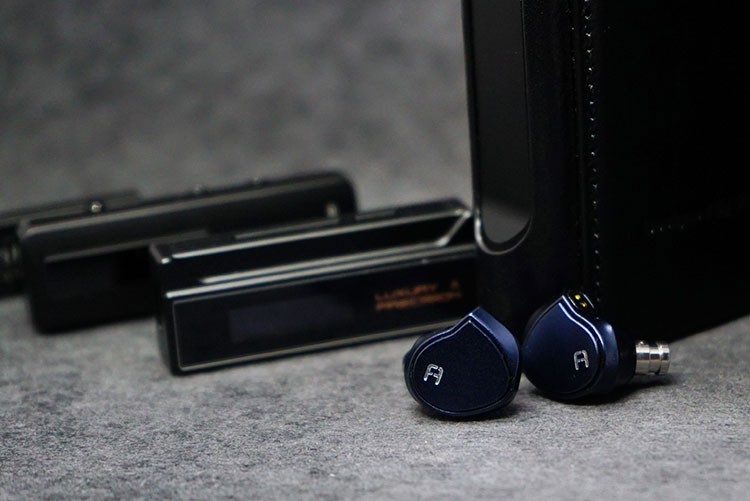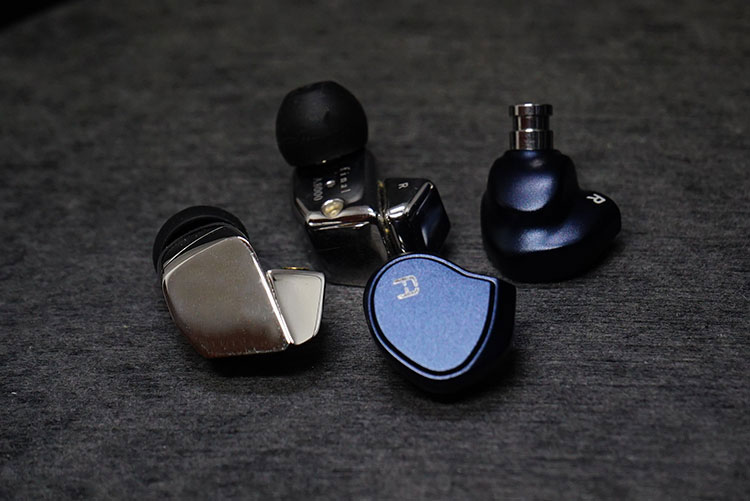FAudio Dark Sky is a flagship 10.2mm double diaphragm single dynamic driver, (fiber & D.L.C.), universal monitor. It is priced at $1150.
Disclaimer: The FAudio Dark Sky sent to us for this review is a purchased unit and does not have to be returned. We thank the team at FAudio and Musicteck for giving us this opportunity.
To read more about Musicteck products we have reviewed previously on Headfonics click here.
Note, this 2-page review follows our new scoring guidelines for 2021 which you can read up on here.
FAudio set off a bit of a single dynamic driver frenzy in Japan and Hong Kong when they launched their single dynamic driver IEM Major a few years ago.
Successor to the more recent release Minor and the Major which is famed to be a “Deity of Dynamic IEMs”, the new Dark Sky epitomizes the series with improved hardware and architecture.
Equipped with a DLC, (Diamond-Like Carbon), driver in a patented acoustic chamber, let’s check if the “Dark Sky” performs to expectations.
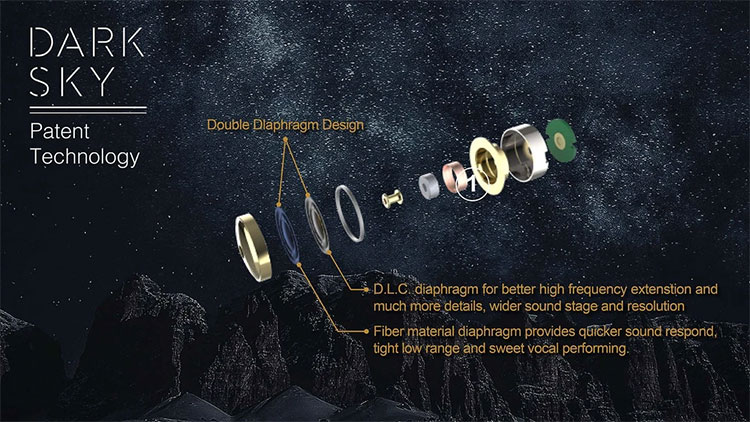
Tech Highlights
The Dark Sky comes in the same housing on Minor and Major with a dark blue paint job, but when looking into the specifications and design you will realize it is completely revamped.
The new design adopts a 10.2mm rigid DLC (Diamond-Like Carbon) driver membrane combined with another artificial fiber membrane layer stacked to achieve maximized treble extension and resolution, enabling tight bass impact and sweet vocals.
The brand’s T.B.A.C (Triple Built-in Acoustic Chamber) technology is also re-designed for Dark Sky, adding metallic structures on the front and rear chambers, holding the driver structure more firmly, and lowering distortion caused by resonances.
According to FAudio, the flux within the magnetic parts is also increased, charging up the sensitivity to handle DLC’s current draw and offering more texture, extension to the mids, and higher frequencies at the same time.
Design
The housing on the Dark Sky is formed by putting together a protruding metallic faceplate with a chamfered edge on a curvy body CNC-machined from Aluminum. It is then finished with fine sandblasting that feels very smooth to the touch.
The whole body is toned Navy Blue, except the nozzle and the white brand logo that provides some nice contrast to the otherwise deep blue tones.
Flipping to the belly of the earpiece the R and L indications are imprinted clearly and align with the markings on the cable. You will see the cable socket extruding at a tilted angle and such allows the cable to curve naturally without an unnatural bend and reduces stress on the ear.
The design flow on the Dark Sky is pretty much identical to the Major or Minor IEMs and all of them look pebble smooth on the inside with a modern touch. However, the Major and Minor were finished in garish colors and the Dark Sky comes in a more tranquil stealthy theme.
Comfort & Isolation
The design blends in angled elements and curves beautifully without sacrificing comfortability. It sits cozily on the outer ear for hours without causing stress. You might think that some of the more angles could cause some pain to the ears after a long listen but this is not the case for the Dark Sky.
If you look closer you will realize the nozzle is tilted at a small degree and align with the ear canal. This helps the earphones to stay in place comfortably without popping out or causing any pressure.
The design of the socket area is also perfect for cable rolling and even with a thick stock cable the Dark Sky still stays on the ear firmly.
Tips
The supplied pack of “ Premium+” ear tips do a good job of enhancing comfort and providing some decent passive noise blockage. The material seems slightly denser than normal tips and with these rather prolonged stock tips the bass sound quite solid and punchy.
FAudio claims that the tips are designed to reduce reflections and it does feel like the long nozzle and thick material within helps shape the sound more controlled and firmer in the lower end. Switching to Spiral Dot tips also yields a good result with the treble sounding less attenuated.
Stock Cable
The 24AWG silver alloy cable that comes with the Dark Sky is terminated with a balanced 2.5mm TRRS plug and 2-pin 0.78mm connectors on the other end. There is good attention to detail including a matching color finish with the main driver shells.
The cable is jacketed with Ultra Soft PVC to avoid oxidization and blends high purity silver, silver alloy cores, and a Gold-infused silver alloy conductor into the main wire. According to FAudio audiophile-grade solder is applied just like some premium after-market cables.
To adapt to more output devices there is also an L shape 3.5mm and 4.4mm converter included allowing the Dark Sky to connect to all outputs in the current market.
Packaging & Accessories
The accessories with the Dark Sky happen to be very innovative. Similar to phone cases the Dark Sky also comes with its own silicone case per driver which I have never seen before. This is one very over-engineered accessory kit that I find amusing though it really could save the IEMs from scratches if it is rolling inside cases without other protection.
Back to the packaging. It has its own style and upon lifting up the box lid, there is a big cover page that introduces you to the content below.
Digging inside you will find the leather case, leather cable binder, converter plugs, and the earphone unit neatly displayed within their EVA foam frames. The open box experience does not stop here. Inside a small box compartment, you will find a protection pouch, cleaning cloth, cleaning brush, small cloth pouch as well as tons of flanges and foam tips.
This is possibly the most complete set of accessories you can imagine unless you want to blame them to have missed out on the in-flight travel adapter?
Sound Impressions
Summary
With the name of Dark Sky, it may have tricked you into thinking the tuning would be dark, though the DLC membrane material hints that this is not the case. Out of the box, the Dark Sky sounds fuller and elaborated in the mid-low frequencies than the Major, which is quite V-shaped and brighter in tone to my ears.
Given 2 weeks of burn-in plus some casual listening, the Dark Sky sounds like a fuller iteration of the Major with a meatier low end that impacts with better agility and more energetically, while the treble is a tad bit more controlled with better layering.
Surprisingly it is very easy to drive and even on my phone with plenty of dynamics and a very fast response.
Bass
There is ample energy in the thump and an agile attack speed. This allows the Dark Sky to sound energetic while maintaining good resolution in the low end with fast percussions and bass intensive hip-hop, EDM tracks.
With explosive test tracks like the 1812 Overture by Tchaikovsky, you can feel the decay speed being quite fast while good air in the mix is captured.
When sufficiently powered you can hear the sub-bass being well present. The 100Hz region has a small bump to add extra texture and meat to the kicks, as well as a soothing weight to guitars that cut through the mixes quite well.
The 200-300Hz region has a nice presence, which adds more body to the lower register notes. A good balance between articulacy and clarity is maintained with just enough rumble to sound deep and expanded but not boomy.
Testing with synthesized bass test tracks the bass drum slams cleanly with good fullness and power. The same is also for the bass guitars and their overtones which can be clearly heard with a moderately fast attack.
When powered sufficiently by DAPs like Shanling M8, the bass is rendered dense and airy leaving plenty of room to house the upper frequencies.
Mids
The mid-range frequencies on the Dark Sky are what colors it differently from its predecessor Major, which has the midrange more pressed down to achieve higher transparency and wider perceived frequencies extension.
The low-mids on the Dark Sky are slightly forwarded to give more meat to the vocal and acoustic instruments. Together with some boosts in the presence region, the vocal sounds quite pronounced.
While the more intimate low-mids may not match classical music or more complicated compositions, it is expressive with pops and is decently layered.
The midrange is smooth and nowhere dark or dull, with good energy in the 1-2kHz range that brings out more details in the vocal range, especially for lighter voices. The tuning takes away most sibilance thus tilting the signature to the warmer and sweeter side.
Some sparkle is added to give more textures to the overtones and strengthen the resolution which makes it sound very smooth with pop music.
Treble
While the low-mids are quite powerful some frequencies in the treble are lifted to compensate and together it does sound quite balanced and opened up with very slight aggression.
The sibilance zone gets a well-rounded treatment and beyond that point, more energy is added to boost air and crispiness. Cymbals cuts through the mix clearly and the ultra-high frequencies at the top end are not overly boosted to preserve musicality.
With synthesized music, clarinets, horns, and strings it sounds very airy. The Dark Sky is able to bring up the overtones that make resonating sounds such as bells sound dense and textured.
Staging
Having the mid-range frequencies drawn up-front, the vocal experience is more intimate and the staging sounds fairly expanded with instrument positions well defined.
You could hear the bass being quite extended to below 30Hz and the pronounced upper mids get more attention than the upper treble, thus limiting the perceived stage size yet helping it to sound more realistic.
As for the vocal imaging, the lead vocal is placed a few rows in front, spaced nicely while maintaining good thickness and density. Pop music and jazz sound livelier and more musical, without sounding overly thick or poorly imaged.
However, when more instruments come in the mix, the Dark Sky still sounds more clustered than some other IEMs that has the mid-range pressed down for smoothness and clarity.
Synergy
Efficiency
The Dark Sky is rated at 24Ω in impedance and 114dB SPL so the 10.2mm driver on Dark Sky can sing quite loud on phones and the laptop. Even with a stiff membrane it still manages to get easily well driven and sound coherent and fast. Even on entry-level DAPs such as the Shanling M3X, it maintains a very stereophonic, layered presentation.
Even without a DAP, the Dark Sky performs very well so this is a brownie point over some other dynamic flagships which require more power to sound optimal.
Pairings
With DAPs that sound denser and smooth in the mids such as the Shanling M8, much more weight, layers and details are carried into the bass. Powerful dongles like the L&P W2 are also a fantastic pairing, which sounds exceptionally smooth and clear in the vocals and upper mids.
Putting on stronger amplification such as pairing with the Soncoz SGA1 you can hear the staging being boosted immediately, and the treble is outlined more clearly. The Dark Sky can scale with good power. The bass impact holds up well, sounding tight and clean. With a powerful source, there will be a stronger thump and a more precise response.
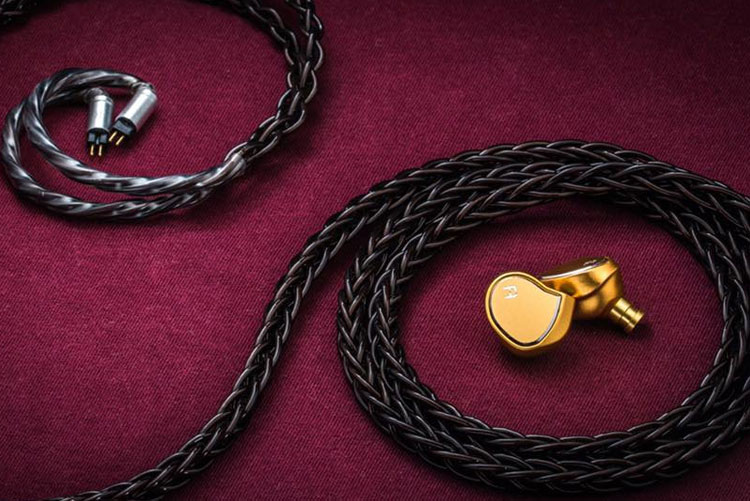
Selected Comparisons
FAudio Major
$1400
Technical
The Major is FAudio’s first dynamic earphones with 6061T6 aluminum housing, the same as what is used for the Dark Sky.
This first iteration of a single dynamic design from the brand introduces the Triple Built-in Acoustic Chamber (T.B.A.C) technology. This controls the air pressure inside the chamber for fast, well-controlled bass and press down unwanted sibilance, enhancing clarity and staging at the same time.
The 10.5mm driver inside also consists of 2 membrane layers including a Titanium and a fiber layer, which aims to combine high sound density and extension with sweet, powerful lower frequencies.
The Major is not as sensitive as the Dark Sky, measuring 110dB @1kHz in sensitivity and 32Ω in impedance, whereas the Dark Sky is 114dB @1kHz and 24ohm in impedance, which is easier to drive.
The color scheme on the body of the earphone and the cable marks the biggest design difference with the form factor identical. To me, the Dark Sky looks a lot more appealing and mature as the golden Major is just too gaudy in design.
Performance
While both the Major and Dark Sky is under the same design, the Major is actually less sensitive and outputs a V-shaped, skewed signature compared to the Dark Sky that is much more balanced and swiftly articulated.
The bass on Major is elevated with a less impactful slower decay while the Dark Sky is naturally rendering its bass with speedier impact and with better control.
The lower mids on the Major are also not as defined as on the Dark Sky with some bass bleeding into the vocals. The resolution in the mids is stronger on the Dark Sky and it sounds more authentic with a gentle lift in the midrange frequencies that gives the vocal a nice body.
In contrast, the Major may sound grander, more stretched in staging, and clearer in tone when you play songs that are less bass intensive, because of its more attenuated mids.
The treble on the Major is quite a lot more protruding and cymbals get quite sharp, nearly reaching the threshold to get harsh yet it may favor some electronic music or Japanese vocalists. the Dark Sky is also bright but is much more controlled and rounded, contributing to a more dynamic and natural presentation.
Final A8000
$1999
Technical
Both the A8000 and Dark Sky house a single dynamic driver, however, the A8000 is equipped with a beryllium driver and is tuned in a different direction The A8000 stresses extension and density in the lower mids as well as elevating the treble to sound extremely transparent.
While the Dark Sky is very stealthy in its looks, the A8000 looks and sounds bright. The blingy mirror finish on A8000 is breathtaking like a piece of jewelry on the ear. However, portability is slightly compromised when compared to the lightweight and smaller Dark Sky.
Performance
Both the A8000 and the Dark Sky sound clean but the A8000 is quite a lot brighter when they are A/B tested. However, the bass of the A8000 kicks deeper while the Dark Sky has the bass elevated to sound more dynamic making the A8000 sound deeper but also more tranquil.
The lower mids on the A8000 are also more tamed which contributes to a deeper low-end presentation unlike the more up-front and lively vocals on the Dark Sky. This makes quite a difference in what genres of music these IEMs could fit.
I find the A8000 better for Operas or other vocal pieces that are more solemn, its mids tuning also leaves more room for more instruments of a larger ensemble to be housed. The Dark Sky, on the other hand, works very well with pop and anything that has more mid presence that will make you focus on the virtuoso and solo instruments.
Our Verdict
The Dark Sky beats the Major in clarity, tonal balance as well as giving a much more solid image. It is one of the richest sounding IEM out there with a balanced tone and excellent detail retrieval, even on small outputs.
The Major once turned me away with its over-sharp treble and skewness but the Dark Sky has proven to be a much more mature, comprehensively tuned product that is easier to drive on any gears while being able to scale with stronger amplification.
If you want huge staging the Dark Sky may not be for you, but it will be my solid recommendation for pop and vocal lovers!
FAudio Dark Sky Specifications
- Drivers: 10.2mm dual membrane moving coil unit
- Frequency response: 15Hz~38KHz
- Impedance: 24Ω @1kHz
- Sensitivity: 114dB@1KHz

